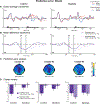Electrophysiological correlates of perceptual prediction error are attenuated in dyslexia
- PMID: 34801517
- PMCID: PMC8807066
- DOI: 10.1016/j.neuropsychologia.2021.108091
Electrophysiological correlates of perceptual prediction error are attenuated in dyslexia
Abstract
A perceptual adaptation deficit often accompanies reading difficulty in dyslexia, manifesting in poor perceptual learning of consistent stimuli and reduced neurophysiological adaptation to stimulus repetition. However, it is not known how adaptation deficits relate to differences in feedforward or feedback processes in the brain. Here we used electroencephalography (EEG) to interrogate the feedforward and feedback contributions to neural adaptation as adults with and without dyslexia viewed pairs of faces and words in a paradigm that manipulated whether there was a high probability of stimulus repetition versus a high probability of stimulus change. We measured three neural dependent variables: expectation (the difference between prestimulus EEG power with and without the expectation of stimulus repetition), feedforward repetition (the difference between event-related potentials (ERPs) evoked by an expected change and an unexpected repetition), and feedback-mediated prediction error (the difference between ERPs evoked by an unexpected change and an expected repetition). Expectation significantly modulated prestimulus theta- and alpha-band EEG in both groups. Unexpected repetitions of words, but not faces, also led to significant feedforward repetition effects in the ERPs of both groups. However, neural prediction error when an unexpected change occurred instead of an expected repetition was significantly weaker in dyslexia than the control group for both faces and words. These results suggest that the neural and perceptual adaptation deficits observed in dyslexia reflect the failure to effectively integrate perceptual predictions with feedforward sensory processing. In addition to reducing perceptual efficiency, the attenuation of neural prediction error signals would also be deleterious to the wide range of perceptual and procedural learning abilities that are critical for developing accurate and fluent reading skills.
Keywords: Adaptation; Dyslexia; Event-related potentials; Expectation; Prediction error; Repetition; Time-frequency.
Copyright © 2021 Elsevier Ltd. All rights reserved.
Conflict of interest statement
Declarations of interest: none
Figures





Similar articles
-
Dysfunction of Rapid Neural Adaptation in Dyslexia.Neuron. 2016 Dec 21;92(6):1383-1397. doi: 10.1016/j.neuron.2016.11.020. Neuron. 2016. PMID: 28009278 Free PMC article.
-
Evidence for spatiotemporally distinct effects of image repetition and perceptual expectations as measured by event-related potentials.Neuroimage. 2018 Apr 1;169:94-105. doi: 10.1016/j.neuroimage.2017.12.029. Epub 2017 Dec 13. Neuroimage. 2018. PMID: 29247805
-
Perceptual Salience and Reward Both Influence Feedback-Related Neural Activity Arising from Choice.J Neurosci. 2015 Sep 23;35(38):13064-75. doi: 10.1523/JNEUROSCI.1601-15.2015. J Neurosci. 2015. PMID: 26400937 Free PMC article.
-
Repetition suppression to faces in the fusiform face area: A personal and dynamic journey.Cortex. 2016 Jul;80:174-84. doi: 10.1016/j.cortex.2015.09.012. Epub 2015 Oct 31. Cortex. 2016. PMID: 26615518 Review.
-
Infant brain responses associated with reading-related skills before school and at school age.Neurophysiol Clin. 2012 Jan-Feb;42(1-2):35-41. doi: 10.1016/j.neucli.2011.08.005. Epub 2011 Sep 17. Neurophysiol Clin. 2012. PMID: 22200340 Review.
Cited by
-
Directed Neural Network Dynamics in Sensorimotor Integration: Divergent Roles of Frontal Theta Band Activity Depending on Age.J Neurosci. 2025 Jul 9;45(28):e0427252025. doi: 10.1523/JNEUROSCI.0427-25.2025. J Neurosci. 2025. PMID: 40399045
-
The Neural Representation of a Repeated Standard Stimulus in Dyslexia.Front Hum Neurosci. 2022 May 12;16:823627. doi: 10.3389/fnhum.2022.823627. eCollection 2022. Front Hum Neurosci. 2022. PMID: 35634200 Free PMC article.
-
Adaptation in auditory processing.Physiol Rev. 2023 Apr 1;103(2):1025-1058. doi: 10.1152/physrev.00011.2022. Epub 2022 Sep 1. Physiol Rev. 2023. PMID: 36049112 Free PMC article. Review.
-
Is there evidence for a noisy computation deficit in developmental dyslexia?Front Hum Neurosci. 2022 Sep 30;16:919465. doi: 10.3389/fnhum.2022.919465. eCollection 2022. Front Hum Neurosci. 2022. PMID: 36248689 Free PMC article.
-
Atypical reliance on monocular visual pathway for face and word recognition in developmental dyslexia.Brain Cogn. 2024 Feb;174:106106. doi: 10.1016/j.bandc.2023.106106. Epub 2023 Nov 28. Brain Cogn. 2024. PMID: 38016399 Free PMC article.
References
-
- Ahissar M, Lubin Y, Putter-Katz H, & Banai K (2006). Dyslexia and the failure to form a perceptual anchor. Nature Neuroscience, 9(12), 1558. - PubMed
-
- Arciuli J, & Simpson IC (2012). Statistical learning is related to reading ability in children and adults. Cognitive Science, 36(2), 286–304. - PubMed
-
- Baldeweg T (2007). ERP repetition effects and mismatch negativity generation: A predictive coding perspective. Journal of Psychophysiology, 21(3–4), 204–213.
Publication types
MeSH terms
Grants and funding
LinkOut - more resources
Full Text Sources

